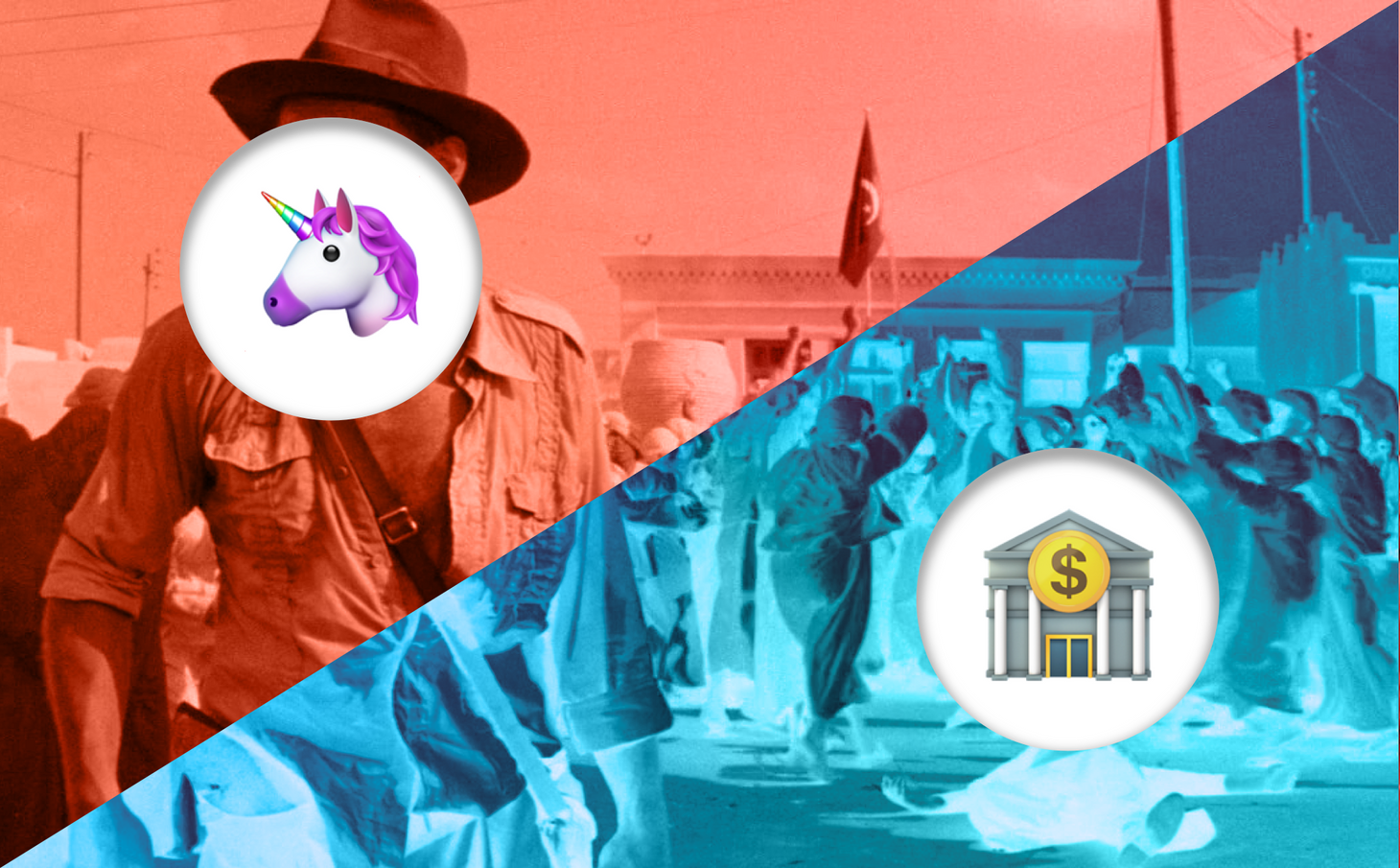Raiders of the lost Bank
Want to know the future of work? Don't ask a Wall Street CEO. Ask a protocol.

In Raiders of the Lost Ark, Indiana Jones is trying to escape out of a Cairo bazaar. After punching his way through a dozen or so locals, he finds himself cornered by a master swordsman. The local is waving his sword in an elaborate pattern, indicating to the American archeologist that his time is up. The exhausted Indy frowns, pulls out his gun, shoots, and walks away as the swordsman collapses to the floor.

Forty years later, this is still the most iconic scene in one of the most successful movie franchises of all time. It manages to sum up the 20th Century in a few seconds, without saying a word. It shows us a masterful representative of the old world, with his elegant weapon, traditional attire, an air of invincibility. And, facing him, a representative of the new world, with an air of impatience, modern clothes, and the technology to dispatch his enemy at the flick of a finger.
A similar scene is playing out at an office near you. Representatives of the old world, in traditional attire, are brandishing their ancient weapons with an air of invincibility. Earlier this week, Jamie Dimon, the CEO of JPMorgan Chase, shared his plans for September:
“We want people back to work, and my view is that sometime in September, October, it will look just like it did before. And everyone is going to be happy with it, and yes, the commute, you know people don’t like commuting, but so what... I’m about to cancel all my Zoom meetings… I’m done with it.”
Mr. Dimon is facing a technological threat that can, ultimately, dispatch him at the flick of a finger. But he doesn’t realize it.
Part of the story is remote work. Also this week, Sundar Pichai, the CEO of Google, announced that the company expects (only) 60% of its employees to return to the office post-Covid. The rest will be fully remote or work from new satellite offices. And even those who will return to the old office will only be expected to be there three days a week.
Tech companies have already overtaken banks as the premier destination for the world’s best and brightest — not just engineers but also MBAs. This trend is likely to accelerate dramatically over the next few years.
But the biggest threat to Mr. Dimon’s fiefdom (“people don’t like commuting, but so what!”) is different. Technology will not just take Wall Street’s talent; it will take Wall Street’s business. And most JPMorgan employees will not become tech employees; they will become redundant.
Dimon is not the only one stuck in the previous century. His whole organization and industry are there with him. The amount of people and paperwork involved in every simple interaction with these organizations is comical. Banks are seen as “ruthless capitalists,” but the level of inefficiency, incompetence, and wasted effort within them is mind-boggling.
Meanwhile, try to open a retirement account on Wealthfront, check your Apple Card balance, and yes, even trade on Robinhood, and you’ll feel like you’re on a different planet. And these three are probably the tamest examples I could come up with — they simply take traditional finance products and make them delightful.
Farther afield, there are whole new products and approaches. Try creating an investment thesis on my friend Ben’s Composer app. Or use Uniswap to trade new currencies or earn interest. These things give me the same goosebumps as that Indiana Jones scene did when I first watched it back in the 1980s. The way they are designed and the way they work blows my mind.
Uniswap, in particular, is fascinating. Ignore for a second the fact that it’s used to trade cryptocurrencies. It is an “app” that processes billions of dollars in trades each week. It enables customers to buy and sell various financial assets without a centralized order book or market maker. Other Uniswap customers provide the liquidity that ensures these trades happen in real-time; they can “park” their money and earn interest. The interest that incentivizes them to do so is calculated automatically based on the supply and demand of different assets.
“App” is not the correct word to describe Uniswap. It is not an app. It is a protocol. Everything that happens on the platform happens automatically, based on smart contracts (code that runs on Ethereum’s decentralized network). This code enables and secures all the transactions, determines exchange rates, fees, interest rates, everything. The protocol is maintained and upgraded by a small team, about 30 people or so, as of April 2021. And it is governed by Uniswap token holders, which includes many of the protocol’s earliest users and anyone else who owns UNI coins.
If the previous paragraph reads like Chinese (or Greek), that’s ok. You don’t need to understand how it works. All you need to know is that a pre-programmed protocol is doing, automatically, what hundreds or thousands of people would do in a traditional financial institution. And it does so without paying giant bonuses, without favoring powerful clients, and without even knowing who the clients are.
There are thousands of similar projects and protocols that address every aspect of finance and beyond. Most of them will fail. Some of them will prove out to be frauds. But a few will survive and evolve. And all of them are already pointing towards a very different future from the one we have today.
Who cares what the CEO of JPMorgan Chase thinks about the future of office?
Over the next decade, most of the change in the way offices (and cities) are used will not come from giant companies willfully changing how they work. It will come from the emergence of new giants that work entirely differently.
🎤 Are you looking for a keynote speaker for your next event, corporate offsite, or investor meeting? Every year, I inform and inspire thousands of executives across the world. Visit my speaker profile to learn more and get in touch with my agent.
Dror Poleg Newsletter
Join the newsletter to receive the latest updates in your inbox.

